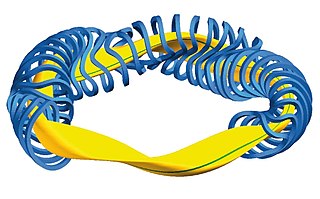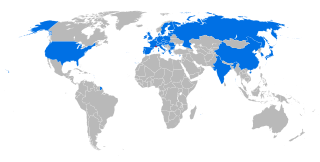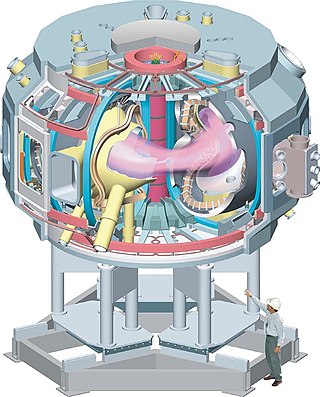SPARC (Scalable Processor Architecture) is a computer instruction set architecture.
SPARC may also refer to:

A stellarator is a plasma device that relies primarily on external magnets to confine a plasma. Scientists researching magnetic confinement fusion aim to use stellarator devices as a vessel for nuclear fusion reactions. The name refers to the possibility of harnessing the power source of the stars, such as the Sun. It is one of the earliest fusion power devices, along with the z-pinch and magnetic mirror.

A tokamak is a device which uses a powerful magnetic field to confine plasma in the shape of a torus. The tokamak is one of several types of magnetic confinement devices being developed to produce controlled thermonuclear fusion power. As of 2016, it was the leading candidate for a practical fusion reactor.

Princeton Plasma Physics Laboratory (PPPL) is a United States Department of Energy national laboratory for plasma physics and nuclear fusion science. Its primary mission is research into and development of fusion as an energy source. It is known in particular for the development of the stellarator and tokamak designs, along with numerous fundamental advances in plasma physics and the exploration of many other plasma confinement concepts.

Fusion power is a proposed form of power generation that would generate electricity by using heat from nuclear fusion reactions. In a fusion process, two lighter atomic nuclei combine to form a heavier nucleus, while releasing energy. Devices designed to harness this energy are known as fusion reactors. Research into fusion reactors began in the 1940s, but as of 2022, only one design, an inertial confinement laser-driven fusion machine at the US National Ignition Facility, has in any sense produced a positive fusion energy gain factor, i.e. more power output than input.

Devens is a regional enterprise zone and census-designated place in the towns of Ayer and Shirley and Harvard in the U.S. state of Massachusetts. It is the successor to Fort Devens, a military post that operated from 1917 to 1996. The population was 1,840 at the 2010 census.
This timeline of nuclear fusion is an incomplete chronological summary of significant events in the study and use of nuclear fusion.

ITER is an international nuclear fusion research and engineering megaproject aimed at creating energy through a fusion process similar to that of the Sun. Upon completion of construction of the main reactor and first plasma, planned for late 2025, it will be the world's largest magnetic confinement plasma physics experiment and the largest experimental tokamak nuclear fusion reactor. It is being built next to the Cadarache facility in southern France. ITER will be the largest of more than 100 fusion reactors built since the 1950s, with ten times the plasma volume of any other tokamak operating today.

Magnetic confinement fusion is an approach to generate thermonuclear fusion power that uses magnetic fields to confine fusion fuel in the form of a plasma. Magnetic confinement is one of two major branches of fusion energy research, along with inertial confinement fusion. The magnetic approach began in the 1940s and absorbed the majority of subsequent development.

A spheromak is an arrangement of plasma formed into a toroidal shape similar to a smoke ring. The spheromak contains large internal electric currents and their associated magnetic fields arranged so the magnetohydrodynamic forces within the spheromak are nearly balanced, resulting in long-lived (microsecond) confinement times without external fields. Spheromaks belong to a type of plasma configuration referred to as the compact toroids. A spheromak can be made and sustained using magnetic flux injection, leading to a dynomak.
Robert L. Hirsch is an American physicist who has been involved in energy issues from the late 1960s. Through the 1970s he directed the U.S. fusion energy program at a variety of government positions as responsibility for the project moved from the Atomic Energy Commission to the Energy Research and Development Administration and finally to the Department of Energy. After that time he was a senior energy program adviser for Science Applications International Corporation and is a Senior Energy Advisor at MISI and a consultant in energy, technology, and management.

The National Compact Stellarator Experiment, NCSX in short, was a magnetic fusion energy experiment based on the stellarator design being constructed at the Princeton Plasma Physics Laboratory (PPPL).

A spherical tokamak is a type of fusion power device based on the tokamak principle. It is notable for its very narrow profile, or aspect ratio. A traditional tokamak has a toroidal confinement area that gives it an overall shape similar to a donut, complete with a large hole in the middle. The spherical tokamak reduces the size of the hole as much as possible, resulting in a plasma shape that is almost spherical, often compared to a cored apple. The spherical tokamak is sometimes referred to as a spherical torus and often shortened to ST.
Robert James Goldston is a professor of astrophysics at Princeton University and a former director of the Princeton Plasma Physics Laboratory.
The ARC fusion reactor is a design for a compact fusion reactor developed by the Massachusetts Institute of Technology (MIT) Plasma Science and Fusion Center (PSFC). ARC aims to achieve an engineering breakeven of three. The key technical innovation is to use high-temperature superconducting magnets in place of ITER's low-temperature superconducting magnets. The proposed device would be about half the diameter of the ITER reactor and cheaper to build.

The Princeton Large Torus, was an early tokamak built at the Princeton Plasma Physics Laboratory (PPPL). It was one of the first large scale tokamak machines, and among the most powerful in terms of current and magnetic fields. Originally built to demonstrate that larger devices would have better confinement times, it was later modified to perform heating of the plasma fuel, a requirement of any practical fusion power device.
Commonwealth Fusion Systems (CFS) is an American company founded in 2018 aiming to build a compact fusion power plant based on the ARC tokamak power plant concept. The company is based in Cambridge, Massachusetts, and is a spin-off of the Massachusetts Institute of Technology (MIT). CFS has participated in the United States Department of Energy’s INFUSE public-private knowledge innovation scheme, with several national labs and universities.
The history of nuclear fusion began early in the 20th century as an inquiry into how stars powered themselves and expanded to incorporate a broad inquiry into the nature of matter and energy, as potential applications expanded to include warfare, energy production and rocket propulsion.
The Compact Ignition Tokamak (CIT) was a plasma physics experiment that was designed but not built. It was designed by an inter-organizational team in the USA led by Princeton Plasma Physics Laboratory. The experiment was designed to achieve a self-sustaining Thermonuclear fusion reaction (ignition) in a Tokamak with the minimum possible budget.

Theta-pinch, or θ-pinch, is a type of fusion power reactor design. The name refers to the configuration of currents used to confine the plasma fuel in the reactor, arranged to run around a cylinder in the direction normally denoted as theta in polar coordinate diagrams. The name was chosen to differentiate it from machines based on the pinch effect that arranged their currents running down the centre of the cylinder; these became known as z-pinch machines, referring to the Z-axis in cartesian coordinates.